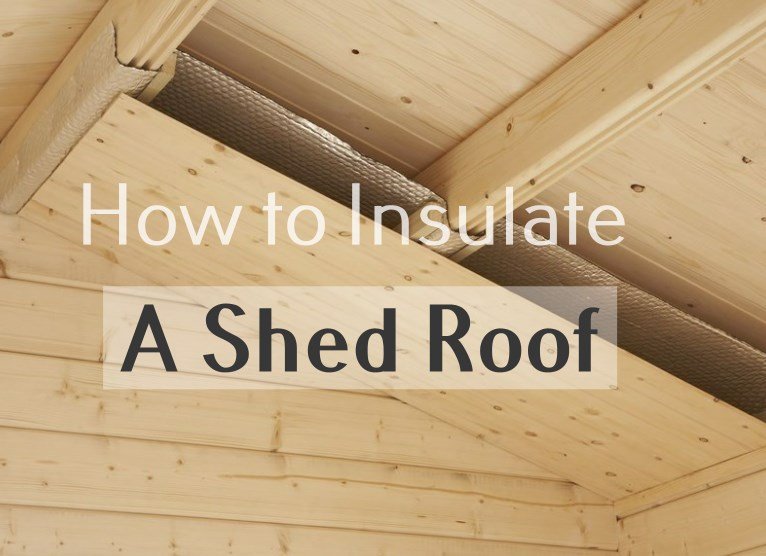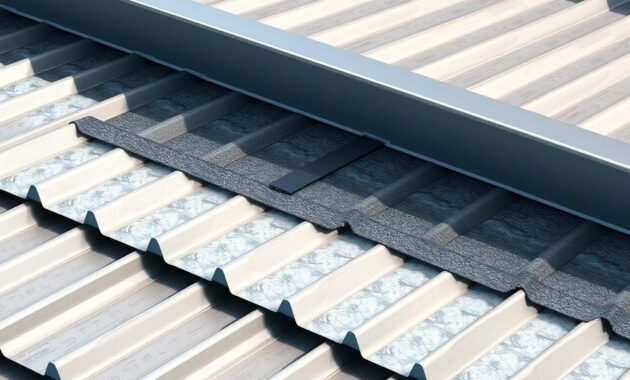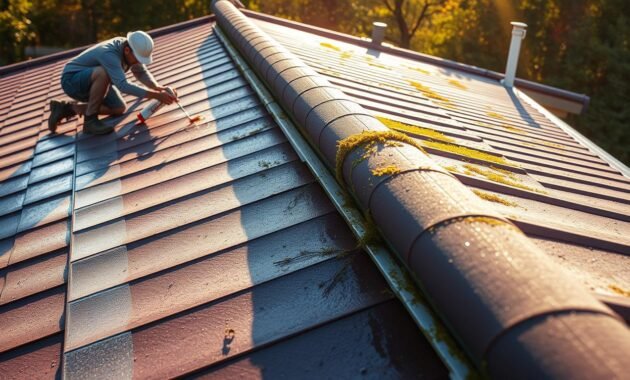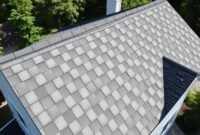Are you tired of freezing in your shed during winter or sweating through summer heat? Inadequate roof insulation can make your storage space uncomfortable. It damages your items and wastes energy. But, I’ll guide you on how to insulate your shed roof and metal roof well.
This will make your space comfortable and energy-efficient. In this detailed guide, I’ll show you every step of metal roof insulation. Whether you need a cozy workshop or to protect your belongings, I’ll share easy and affordable techniques. Get ready to improve your shed’s comfort and performance!

Understanding Shed and Metal Roof Insulation Basics
Roof insulation is key to keeping your shed or metal structure comfy and energy-saving. Without it, almost 25% of heat can leak out. This makes insulation vital for saving energy and protecting your investment.
Benefits of Proper Insulation
An energy-efficient shed roof brings many benefits. I’ve found that good insulation offers several advantages:
- Significant reduction in heating and cooling costs
- Improved temperature regulation
- Protection against moisture damage
- Extended lifespan of the building structure
Key Considerations Before Starting
Before starting on roof insulation, consider a few important things. Your local climate, building codes, and how you plan to use the space matter a lot.
Temperature Control and Energy Efficiency
Stopping roof condensation is essential for a healthy inside. Good insulation creates a barrier that stops moisture buildup and prevents damage.
Choosing the right insulation can turn your shed or metal roof into a cozy, energy-saving space. Knowing these basics helps you make smart choices for your insulation project.
Read also: How to Install Corrugated Metal Roofing On A Shed
Essential Tools and Materials Needed
Starting a roof insulation project needs careful planning and the right tools. When doing diy roof insulation, having the right tools is key. It makes the project go smoothly and efficiently.
Your safety is the most important thing. Make sure you have the following protective gear before you start:
- Safety glasses or goggles
- Work gloves
- Dust mask or respirator
- Long-sleeved clothing
- Non-slip work boots
Here are the tools you’ll need for roof insulation:
- Measuring tape
- Utility knife
- Straight edge or ruler
- Caulking gun
- Staple gun
- Ladder or scaffolding
Buying materials from local stores like Home Depot or Lowe’s is a good idea. Look for deals and compare prices to save money.
If you’re watching your budget, consider buying in bulk and renting tools. Quality materials are worth the investment to avoid future costs.
Types of Insulation Materials for Roofs
Choosing the right insulation material is key for a good roof. It affects how well your roof works and how much energy it uses. Different materials help make your shed or metal roof more comfy and save money.
I’ll look at the most popular insulation types. This will help you choose wisely.
Fiberglass Insulation Options
Fiberglass insulation is a favorite for many. It’s affordable and works well in many places. It comes in two main types:
- Batts and rolls: These are pre-cut panels for roof framing
- Loose-fill fiberglass: This is blown into tight spots
Fiberglass insulation has R-values from R-2.2 to R-2.7 per inch. It’s a good choice for insulation.
Spray Foam Solutions
Spray foam insulation seals air well and keeps heat in. There are two main types:
- Open-cell foam: It’s soft and flexible, with R-values around R-3.5 per inch
- Closed-cell foam: It’s denser and has higher R-values up to R-6 per inch
Rigid Foam Board Varieties
Rigid foam boards are great for keeping heat out and protecting from moisture. Here’s a quick look at the different types:
| Foam Type | R-Value per Inch | Best Use |
|---|---|---|
| XPS (Extruded Polystyrene) | R-5 | Moisture-resistant applications |
| EPS (Expanded Polystyrene) | R-3.6 | Cost-effective insulation |
| PIR (Polyisocyanurate) | R-6.8 | High-performance insulation |
Each insulation material has its own benefits. Your roof type, budget, and needs will help you choose the best one.
How to Insulate a Shed Roof
Insulating a shed roof is easy if you know the right steps. I’ll show you how to do it yourself and make your shed more energy-efficient.
There are two main ways to insulate a shed roof: cold roof and warm roof. Each method has its own benefits, depending on your shed’s use and location.
- Cold Roof Insulation: Best for sheds with limited interior space
- Warm Roof Insulation: Ideal for sheds used as workshops or storage areas
To successfully insulate your shed roof, follow these steps:
- Measure your roof’s dimensions accurately
- Select appropriate insulation material
- Prepare the roof surface
- Install vapor barriers
- Apply insulation carefully
Choosing the right insulation is key. Fiberglass, rigid foam boards, and spray foam are good options. Think about your shed’s purpose and local weather when picking.
By following these steps, you can make your shed more energy-efficient. This will also protect your items from extreme temperatures.
Preparing Your Roof Surface
Getting your roof ready for insulation is key to avoiding moisture problems. It’s important to clean, inspect, and install vapor barriers. This helps prevent roof condensation.
Cleaning and Inspection Steps
First, do a thorough roof check. Remove any debris, dirt, or loose stuff. Look for signs of trouble like:
- Visible water stains
- Rust or corrosion spots
- Warped or damaged roofing materials
- Signs of previous moisture damage
Addressing Repairs and Damage
Fixing roof damage is vital for vapor barriers to work well. Small problems can turn into big ones if not fixed. Make sure to repair:
- Cracked or broken roof panels
- Holes or punctures
- Loose fasteners
- Seal breaks around roof penetrations
Installing Vapor Barriers
Vapor barriers keep moisture out. Here’s how to pick and put them on your roof:
| Vapor Barrier Type | Best Used For | Effectiveness Rating |
|---|---|---|
| Polyethylene Sheet | Metal and Shed Roofs | High |
| Foil-Faced Insulation | Unheated Spaces | Medium |
| Spray-Applied Barriers | Complex Roof Structures | Very High |
Installing vapor barriers needs careful work. Make sure to cover the whole roof, seal seams, and avoid gaps. This helps prevent roof condensation.
Installing Insulation in Metal Roofs

Insulating metal roofs needs a smart plan to keep them cool and save energy. Metal roofs have special needs that require special care and methods.
For the best results, focus on a few key areas:
- Choose the right insulation for metal roofs
- Deal with moisture problems
- Make sure insulation covers all fasteners and seams
- Keep good airflow during installation
There are several top choices for insulating metal roofs:
| Insulation Type | R-Value | Best Used For |
|---|---|---|
| Spray Foam | 3.6 – 7 per inch | Comprehensive coverage, air sealing |
| Rigid Foam Boards | 4 – 6 per inch | Lightweight metal structures |
| Fiberglass Batts | 2.2 – 4.3 per inch | Cost-effective retrofit solutions |
For complex projects, getting expert advice is a must. Good insulation stops moisture, cuts energy bills, and makes your roof last longer.
Key steps for a successful job include:
- Prepare the roof surface well
- Pick the best insulation for your roof
- Ensure full coverage without harming the roof’s strength
Proper Ventilation Techniques
Ventilation is key to keeping your shed roof energy-efficient and dry. Without enough air flow, moisture can harm your insulation and structure. I’ll show you the best ways to ventilate your roof for its best performance.
Importance of Air Flow
Good air flow stops roof condensation. Trapped warm, moist air can cause:
- Mold and mildew growth
- Wood rot and structural damage
- Reduced insulation effectiveness
- Increased energy costs
Ventilation Solutions
Here are some effective ventilation methods for your shed roof:
- Ridge vents for continuous air circulation
- Soffit vents to allow cool air intake
- Gable vents for cross-ventilation
- Mechanical exhaust fans for larger spaces
Preventing Condensation
To stop roof condensation, create a balanced ventilation system. Use 1 square foot of ventilation for every 150 square feet of attic space. Install vapor barriers and place vents wisely to manage moisture and keep your roof healthy.
Sealing and Finishing Techniques
Finishing your roof insulation project needs careful attention to details. As an experienced insulation pro, I’ll share key tips for a perfect seal and top performance.
Creating a good air gap is key to stop moisture buildup and keep warmth in. Use special sealing materials to fill gaps between insulation and roof.
- Use high-quality silicone caulk for small gaps
- Apply foam strips around edges and joints
- Install weatherstripping to prevent air leakage
- Check for possible heat transfer points
When working with metal roofs, focus on the air gap between insulation and roof. This gap is vital for air flow and stopping moisture. My best tips include using spacer clips or furring strips for a consistent gap.
Finishing touches are very important. Cut off excess insulation, smooth out surfaces, and make sure all connections are tight. A well-sealed roof boosts energy efficiency and protects against moisture damage.
Remember, sealing is the last line of defense against heat loss and outside elements. Spend time on these final steps for lasting insulation performance.
Common Installation Mistakes to Avoid
Installing insulation can be challenging, even for those who have done it before. Knowing the common mistakes helps you get a professional-quality job. My experience shows that planning and detail are key when working with insulation.
There are several critical errors to watch out for in insulation installation. These mistakes can affect your project’s success and how well it lasts over time.
Gap and Coverage Problems
Improper installation can lead to gaps in your roof’s insulation. These gaps make your roof less efficient and can let in moisture.
- Check for complete coverage around rafters and edges
- Use careful measuring techniques
- Cut insulation materials precisely to fit each space
- Avoid compressing insulation, which reduces its effectiveness
Moisture Control Challenges
Moisture is a big problem for insulation projects. Not using moisture barriers correctly can damage your roof and make insulation less effective.
- Install vapor barriers correctly
- Seal possible water entry points
- Ensure proper roof ventilation
- Use moisture-resistant insulation materials when appropriate
Critical Installation Errors
Making technical mistakes can lower your roof’s energy efficiency. Always be precise and follow the manufacturer’s instructions closely.
- Measure twice, cut once
- Use appropriate protective gear
- Follow local building codes
- Consider professional consultation for complex projects
Avoiding these mistakes will help you create a better, longer-lasting insulation system. This will protect your property and save energy.
Maintenance and Long-term Care

Keeping your energy-efficient shed roof in good shape is key. Regular care protects your investment and keeps your shed cool or warm all year. Here are some tips to keep your roof in top shape.
Begin with regular visual checks, at least twice a year. Look for damage, moisture, or insulation problems. These checks can save you money and keep your roof efficient.
Read also: Metal Roof Coating to Reduce Heat the Metal Roof
- Inspect roof surfaces for cracks or gaps
- Look for signs of moisture or water damage
- Check ventilation systems are clear and functional
- Remove debris that might compromise insulation performance
Different insulation types need different care. Fiberglass is delicate, while spray foam needs a pro check now and then. Watch for these signs that your shed roof might need some love:
- Unexplained temperature changes
- Higher energy bills
- Mold or mildew
- Compressed or sagging insulation
Make a maintenance plan to track your roof’s health. This way, you can spot issues early and keep your shed’s roof efficient for years.
Cost Considerations and Budget Planning
Planning your roof insulation project needs careful thought about money. The cost can change a lot based on several important factors. I’ll share key budgeting tips to guide you.
When looking at insulation options, knowing the cost is key. Different materials and ways to install them can change your total cost a lot.
- Fiberglass insulation: Most budget-friendly option
- Spray foam: Higher initial cost but excellent energy efficiency
- Rigid foam board: Mid-range pricing with good thermal performance
Now, let’s look at the typical costs for roof insulation:
| Insulation Type | Cost per Square Foot | Overall Project Cost Range |
|---|---|---|
| Fiberglass Batts | $0.50 – $1.50 | $500 – $1,500 |
| Spray Foam | $1.50 – $3.00 | $1,500 – $3,500 |
| Rigid Foam Board | $1.00 – $2.50 | $1,000 – $2,800 |
Adding professional installation can increase costs by 30-50%. Doing it yourself can save money, but it needs special skills and tools. It’s wise to get several quotes and think about your roof’s needs.
Quality roof insulation can save a lot of money in the long run. The upfront cost might seem high, but you’ll save on heating and cooling bills.
- Calculate possible energy savings
- Look for local energy rebates
- Think about long-term savings
Pro tip: Always consider your local climate, roof type, and insulation needs when planning your budget.
Conclusion
Insulating a shed roof is more than a home project—it’s an investment in comfort and saving energy. The metal roof insulation guide we’ve looked at offers clear steps to protect your structure from extreme temperatures.
Every roof is different, and choosing the right insulation is key to its performance. Whether it’s a small shed or a large metal building, knowing about insulation materials and how to install them is essential. My advice is to take a complete approach to avoid future problems.
Following this guide will improve your roof’s thermal performance and make it last longer. Insulation saves on energy costs, prevents moisture damage, and keeps the inside stable. Remember, good preparation, precise installation, and regular upkeep are vital for the best results.
Read also: What are the Disadvantages of Metal Sheds?
Getting a well-insulated roof might seem hard, but with the right knowledge, you can make your shed or metal building energy-efficient. It will withstand different weather conditions. Your effort to learn these principles will bring comfort and protection for many years.




